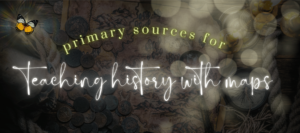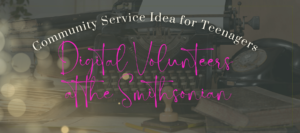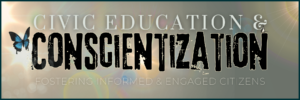What is the definition of a feminist, or of feminism itself? How much do these definitions matter when we talk about the politics of representation? And to what extent does this matter when discussing or teaching about feminism? One would hope a whole hell of a lot.
When I was creating the curriculum to build my gender studies class, I had such a hard time finding any resources for how to teach about feminism in any capacity that scratched beyond the surface of the USA-centric “the 3 waves of feminism” trope. Any teaching resources I could find about feminism in history or feminist theory were either too boring, too oversimplified, or too problematic (If Susan B. Anthony is on your list of “feminists” to teach about, you are doing it wrong).
Honestly, in the age of the commodification of feminism, which is, inherently, anti-feminist, do we really stand a chance?
I wanted to give a backstory to the “History of Feminism Inquiry Project“, that I set up as my very first and free resource on TPT. It is imperfect and incomplete, and actually still needs a lot of work to make complete sense, and needs connected lessons/resources to be fully implemented for someone who doesn’t come from a feminist theory background. Which I suppose defeats the purpose of offering it as a representative resource… and is perhaps inadvisable. Which is uncharacteristically vulnerable on my part, but I am trying something new. I will probably change the “assess the general quality of my work” download” in the future to offer something more immediately useful, but for now, I have this there mostly because I like the story behind it.
You see, it wasn’t just me that created this, it was created out of love and in response to the curiosity and needs voiced by my students, and that process is at the heart of feminist pedagogy.
So. This whole thing all started when my students shattered the bubble I was living in by introducing me to the existence of something called “incels” in our world.
Let me preface this by saying this was almost halfway through the year, and we had been intentionally building trust since the first day, many of us before then. I am mentioning this because I strongly believe none of this would have happened in the way that it did had I not put in the intentional work to earn and hold their trust in the time leading up to this
At first, I didn’t believe them, as they were seniors in high school at this point and we had known each other since their seventh grade year; it would not have been the first time they tricked me for their own amusement.
Alas, not this time. This time it was all too real.
And so this time, they had me watch an “episode” of what was evidently a quite popular YouTube show among their kind(by which I mean teenagers), “Middle Ground”. For those of you who also have no idea what half the gibberish or references coming out of the kids these days means, Middle Ground is a program through Jubilee that “explores whether two different groups of people, opposed in their beliefs, can come together empathetically and find middle ground.” Kind of like a Structured Academic Controversy except without peer-reviewed sources required(or any sources, really), not based in any research whatsoever, and with no discernible structure besides what the creators, who appear to be good-hearted, well-meaning tech bros, decide might be some good questions to ask.
Be advised… these are 24 minutes of your life you will never get back. I had no warning, but even if I had, there are not enough benzos in the world that could have helped me. Be all this as it may, I felt it was worth it to share this abomination because this is what our babies are consuming.
As a public service, I also tried narrating the video to make it less painful for you, but I am afraid I was unable to remain neutral. I tried, sort of. Regardless, the main ideas are there.
Anyway.
This is what they brought to me.
Because they trusted me.
Because they declared I simply had to see it, that it was high time I knew what was happening in the real world, and lucky for me, I had them to show me the way.
And as I was watching the pontification of rather underwhelming dogma, I could feel my beloved students’ eyes watching my face.
Watching me watch what they needed me to see: what they needed me to help them make sense of.
And this shows us not only what the backlash against feminism is, which is not that surprising, but the general ignorance shrouding feminism itself.
Patriarchy is a rapidly mutating virus.
One of its most malignant aspects is how it can manipulate public perception of what feminism is into exactly what will weaken it.
By presenting feminism as a nebulous, undefined and open-to-interpretation, low-hanging-fruit that charades as a sort of personal identity as opposed to a concrete vein of philosophy, political movement, literary criticism, or clearly defined school of thought, and bringing in three woefully unprepared yet well-meaning representatives of it, the creators of this “Middle Ground” episode have served as patriarchy’s insidious puppet.I
Middle Ground: Men's Rights vs. Feminism
From MG:
We brought feminists and men’s rights activists together to see if they could find middle ground. The views expressed by cast members in this video do not reflect the views or opinions of Jubilee Media.
We encourage you to do your own research, respect opinions that don’t align with your own and to have empathy!
Participants for this episode and how they introduce themselves:
Side Note: Upon introduction, none of the participants stated pronouns or identified racially or culturally. I have been careful in my discussion of this video to respond to these choices.
Men’s Rights Activists
Zach- is 24 years old
Kursat- 30 PHD student “challenges discrimination against men on college campuses”
Derrick (also goes by “Brendio”)- “YouTuber” aka “incel” (and further defined it without being prompted),
Feminists
Alyesha- writer, poet, teaching artist
Bea- Pet health Industry, 30
Mimi- 24, Graduate student with a degree in health sciences
Can I just point out here: on the MRA side, we have guys actively involved in the men’s rights/incel movement, while representing the “feminist” side, there are no actual feminists (or at least, anyone with a scholarly/activist, or other background), just rational, educated human beings who also happen to be female (I am assuming based on my own biases. They never actually identified pronouns for the audience). And I am guessing believe that they should be entitled to the fundamental human rights outlined in the UNDHR.
How this works: The Middle Ground people make a statement, and then if the participants agree with the statement, they sit down in the chairs provided. If they do not agree, they remain standing. Then, everyone comes together and discusses their thoughts.
Biological Difference
Statement: “I believe men and women are different but equal”.
The women and Kursat sit down.
Bea thinks that as a woman, of course she does not have the same physical strength. The sexes are just built differently, but she doesn’t think that means anyone should be treated any differently. For example, men are just physically stronger! There must be a reason for that. But we should be paid equally, and treated with respect.
Kursat, the almost-but-not-yet-PhD, believes that men and women have inherent biological differences, and actually agrees that they should have equal legal rights. He just thinks the whole systemic discrimination is BS, and everybody knows that this silly wage gap myth has been debunked like so many times. Side note- Kursat, buddy, did you do your own research? I thought USC was a really good school? Are they just giving out PhDs like candy these days? What is happening here.
Now, don’t fret, everybody, because Derrick has studied evolutionary biology QUITE A BIT! (I’m wondering Derrick, was this study also on YouTube?) Derrick assures us that not only do men and women differ in their bone structures and neurology and the chemical balances, he also believes that men and women should not be equal under the law! You see, children are not equal under the law. And its not because we hate children, its because we love them and want to protect them.
Thanks, Derrick. You’re a real gem.
Bea is a master class in composure. Y’all, she somehow even musters a politely quizzical expression as she, in a calm, measured tone, points out to Derrick-also-known-as-Brendio-who-is-a-YouTuber that if the sexes are not equal, then he is inferring that one would be greater than the other (Jacques Derrida would agree with her on principle, but would probably resent me for bringing deconstruction anywhere near feminism). I have no idea how I would have responded in this situation, but I can only hope that when my worth as a human being is being reduced to that of a well-trained pet by someone with the coherence and wit of a drunken honey badger, my fight or flight responses are even half as graceful as this young woman’s. Somehow, I doubt it. Much more likely that I would have burst out laughing maniacally to mitigate my rage. Which is why I never get invited to these kinds of things.
So then Dudley Douchebag (Zach), who has clearly never heard of Derrida, jumps in to explain the thing Bea just said by restating her question/statement in slightly different words. He provides poignant examples to illustrate his point, starting with my personal favorite: child-bearing. You see, women will be much more nurturing and caring, while men are better at the heavy lifting because they are better suited for that role. Zach doesn’t think this makes them any better or any worse, you see. We are just built, created, and born different.
And then Derrick-aka-Brendio pipes in to say he wants to make sure we understand that this doesn’t mean one or the other isn’t better or worse overall, and that really they compliment each other. Beautifully, Zach would like to add. We need each other. For offspring. And, Zach points out, he does not think that equalizing all of this is the most conducive for the overall well-being of the children. And no, he was not saying this ironically. He was being completely serious.
He actually believes this shit. Amazing.
Toxic Masculinity
“I believe toxic masculinity is real”.
Again, only the ladies sit down. There is a brief discussion about the inevitable harm caused by gender regimes on the boys and men they love (not in these specific terms, obvs, I am generalizing).
Then when everyone sits down, Zach asks what toxic masculinity even means. And while I am allergic to this machista, I really appreciate this vulnerability and curiosity.
Defining terms is the first step to being able to actually talk about them.
Derrick rambles on and says more words. I almost feel bad for this guy. He thinks maybe someone should have been tougher on him. Really can’t argue with him here.
Given how asinine this question is, it is no wonder the discussion quickly unravels into a collective pontification of how emotions are actually powerful and the role of the expression of emotions on mental health.
Because again…. not one person on this stage has any foundational understanding of what feminism actually entails.
“Today, women have more advantages than men.”
All the men sit down.
Because of course they do.
They all pontificate, making overarching generalizations loosly tied to the main statement.
Bea uses a personal anecdote and tries to tie it to a larger social process in a way that validates this asinine question
Kursat, the very confident men’s rights advocate, brings up his list of fun facts and points out that there is only one woman on death row in the US, and that women are much more likely to escape the death penalty. This, he says, is just plain, sex-based discrimination.
The ladies agree with him.
I could not help but face plant here and sigh deeply. Yes, men are disproportionately represented in prisons, and even more so on death row. But which men, Kursat? Read a history book and try again. Or. Just watch a documentary. You see, Kursat, feminism teaches us to always be suspicious of monocausal explanations. Feminism demands intersectionality. Reflexivity. You simpleton.
Alyesha refocuses the group by expanding the scope of the discussion to the health needs of women around the globe. Bea brings in the tampon tax (USA). Alyesha offers the ongoing discussion of medical gaslighting for women and touches on an intersectional approach to understanding the issue.
Open Dialogue
We then see Zach sitting on a stool stating that he believes that men should be able to be men, and blah blah men in society blah, be unashamed about being men…”as we were created”. He really emphasizes that word like it means something very specific to him.
And he refers to being “created” a lot.
That’s fun.
Alyesha: Believes and supports human rights for everyone. And when she hears “men’s rights”, she hears anger, and believes it is a setback for all of us. What is it that you people want.
Zach wants to advocate for positive masculinity. But he just really wants to protect the category of “men”. For example, boy scouts, should be just for boys. Also, the courts: the family and marriage court system.
Alyesha finally jumps in to provide several examples of systemic oppression from her personal life as evidence of the disparity between the lived experiences between men and women, and uses this to point out the sheer idiocy of Zach’s repugnant, smug “arguments”, and, perhaps, I am hoping, in a rational response to the violence enacted upon her by the gaslighting inherent in the creation of this episode. But more on that another time.
Mimi tries to neutralize the situation by pointing out that these topics are the subjects of patriarchy(?), and that this is what women are trying to dismantle: the traditional gender roles. Kursat wants to know if there are any feminist organizations who have done anything at all to challenge the bias against men and fathers in the family court system?(wtf? why would they?)
Mimi says YES. Absolutely.(um, again, what?) Kursat then asks for a list of these organizations, because he knows FOR A FACT that these don’t exist. Mimi says she didn’t come with a list of organizations or research. Kursat of course will not let up, and Mimi has nothing, and starts looking at her fellow “feminists” for support… the scene cuts out. (To put Mimi on this stage for this episode was cruel and/or ignorant on the part of Middle Grounds creators.)
We then switch to Kursat sitting on a stool, pontificating about how men are discriminated against in the legal system. There are more words but it honestly just isn’t that interesting. (again, PhD candidate at USC? For real?)
Kursat would like everyone to know that he will not be repeating feminist talking points to other men.
Derrick, who is still wearing the brightest yellow rain jacket I have ever seen, thinks we should all be allies under patriarchy. Maybe we would all be happier if we went back to the past. You know, if we’re all getting married! And staying married! And having kids! And you know, going to church! Is this guy for real?
Back to the point...
Well that was painful. It’s one of those instances where you wonder if you are actually now dumber after having watched this. Such is the age of information, I suppose.
I have a lot of things to say about this video. None of them are particularly nice, but all of them can be solidly backed up by concrete evidence, historical analysis, or specific feminist theorists. Which is more than I can say for any of the MRA clowns in this video, as that would have required them to have opened a book at some point in their lives.
However, for the purposes of this post, let me focus on the one point for which I shared this video with you and specifically for this post.
How to teach about feminism.
So.
As we noticed, none of the young people representing “feminism” for the purposes of this middle ground exercise are proponents of any particular school of feminism, or have any specific feminist ideologies or background beyond the general belief that women are people. And while that sentiment is cute as a bumper sticker, that is not, in fact, feminism, nor is it representative of the depths of scholarship, analysis, philosophy, and political and social activism the term truly carries.
So while we have very specific bozos representing highly specified and unique aspects of newly coined bullshit patriarchal regimes with defined points of view(however ridiculous), “feminism” is represented as nebulous, undefined, up for interpretation… there were no actual feminists on that stage.
Rather, there are young women who identify as feminists, with varying definitions of the term, representing an overall societal shift in perceptions of gender roles. And while this in and of itself is fine, even progress, I guess, I could not let go of the realization that patriarchal mass media continues to win by obfuscating the hard work and realities of what feminism is and has done.
Feminisms, plural, assume that since all individuals occupy particular social locations in terms of race, class, ethnicity, gender, sexuality, age, and ability at all times, a person is necessarily a combination of these multiple identities that shape their social experiences. At certain times, specific dimensions of their identities may be more salient than at others, but at no time is anyone without multiple identities.
Feminism, in general, assumes categories of identity are intersectional, influencing the experiences that individuals have and the ways they see and understand the world around them. In short… If it has reached this point in time and isn’t intersectional, it simply isn’t feminism. (Thus, Mimi identifying as an “intersectional” feminist was painfully redundant, like asking for queso with cheese.)
More than anything, I could not let my students leave me that year without a concrete understanding that feminism is never, has never been, and will never be, just one thing.
And that this constant state of flux, this never-ending process of becoming and of deciding, this ongoing deliberation about gender, identity, agency, and what it means to go forward… this is the whole point. It’s in the collective having of these conversations together that feminism exists, in the listening to each other, and in the forging of new spaces and ways of being that we have even a chance.
Ok great but…so….. how do you teach and assess that though?
I just started with the students.
After the video was over, they had so many things to say. To me, to each other, to the walls….. so I just let them.
Most of them were making fun of the MRA guys, which… fair. And to be completely honest…. I may have laughed along.
Maybe I’m biased, but these kids were just so delightfully clever and witty, especially that day when they were mocking the unspeakable vitriol packaged as “controversy”.
And there was something cathartic in coming together to ridicule that which tried to threaten and demean our humanity and very existence.
As a teacher, especially in public education when you are acting as an instrument of the state, you are supposed to always be “neutral” and “objective”. And generally I agree with that, for gen ed classes.
But this was our class, our Gender Studies class, and part of what I was doing was modeling feminism, and feminist pedagogy.
And in a feminist classroom, “neutral” and “objective” are not only myths, they are acts of violence.
We closed with a discussion of what elements of feminism we had been able to identify in the video. And once they actually started deconstructing it, they were surprised how very little evidence of actual feminism was there.
And this brings me to my point, and how we created our inquiry project.
First, their questions:
- What is the definition of a feminist?
- When was feminism created?
- How long has feminism been around?
- Why do you keep saying TERFs aren’t actually feminists?
- WHAT IS FEMINISM?
And here is what we came up with, as a way to divide and conquer:
Feminism Research Project Guidelines
The student got into pairs and groups of three and signed up to research different philosophies and approaches to feminism, both past and present.
Each group was then responsible for preparing an informative presentation, with visuals, discussion questions, and/or activities to teach their classmates about their particular feminism.
- Equity feminism
- Multiracial feminism
- Ecofeminism
- Post-structural/French feminism
- Liberal feminism
- Libertarian/ Classical-liberal feminism
- Anarcho-feminism
- Decolonial/Intersectional feminism
- Sex positive feminism
- Separatist feminism
- Postmodern feminism
- Standpoint feminist theory/ standpoint feminism
- Anti-porn feminism
- Psychoanalytic feminism
- Postfeminism
- Womanism
- Transfeminism
- Native American feminism
- Transnational feminism
- Third World feminism
- Postcolonial feminism
- Lesbian feminism
- Cultural feminism
- Socialist feminism
- Islamic feminism
- Performative feminism
- Traditional Marxist feminism
- Radical feminism
- Female supremacists
- Humanist feminists
- Why It Exists: What Evil(Social Phenomenon) Does It Address?
-
-
- Source Of Gender Inequality
- Understanding/Definitions Of Gender
- Primary Identities Considered Within Context Of Reflexivity
-
- What Is The Root Cause Of Power Imbalance In Question; Identification And Explanation Of The Problem
-
-
- Concrete Analysis With A Specific Example: Situate Personal Experience Within Multiple Levels Of Analysis (Micro, Meso, Macro) To Clearly Illustrate Social Phenomenon
- This Can Be Real Or Imagined, But Must Be Grounded In Research.
- Provide A Visual
-
- How Change Will Come:
-
-
- Agency And Limitations
- Proposed Solutions And Justifications
-
- What Activism Looks Like:
-
-
- Provide Examples Of Significant Historical Figures; Publications; Events
-
- Criticisms Of This Approach/Philosophy
-
- By Whom; General Or Specific
- Student’s Own Critique/ Analysis OfLimitations And/Or Blind Spots
- Points Of Contention With Other Feminisms? Famous Debates?
- Current Organizations, People, And Movements That Are Proponents Of This Type Of Feminism (If Applicable)
- Around The World
- In The USA
- In Your State
I also told them:
As you learn about all the brave people who came before you and the many different ways they have come together to overcome injustice, you will find you will start developing your own feminist philosophy based on the time and place you exist.
It won’t be the same as what everyone else believes.
Even other feminists.
This is good.
This is the point.
This is how it all begins.
Download this free resource to see the project for yourself! It was created with and for my students out of love. It also was based on specific units they had already studied, and so I will be adding those onto my TPT store as I go.
More than anything, this resource represents a time when I stopped what I was doing, put aside what I had planned, and made space for what my students needed.
I listened, and watched, and then listened some more. And together, we found a way to construct knowledge together in a way that was meaningful to us, and that met the needs they expressed.
It required me to be humble, and vulnerable, and to adapt to them.














